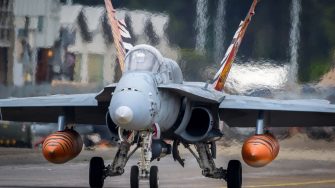A lightweight concrete could be the answer to more durable runways
Crushed brick concrete is ideal for defence airfields that are exposed to high temperatures daily.
Crushed brick concrete is ideal for defence airfields that are exposed to high temperatures daily.

With the Perth Airport tarmac recently being ripped up from a plane taking off, it raises the question how this happened and is there something to prevent this in the future for other airports across Australia.
A UNSW Canberra academic is investigating lightweight aggregate concrete (LWAC), a concrete that contains lightweight materials like crushed brick or fly ash, as an alternative concrete that performs better when exposed to high temperatures and chemicals, something airfield tarmacs are exposed to daily.
Dr Safat Al-Deen’s research has found a LWAC with crushed brick to be ideal for defence airfield concrete as it will significantly enhance their durability and resistance to harsh conditions.
“When exposed to high temperatures, LWAC doesn’t break down as quickly as regular concrete, instead the structure of the concrete allows it to absorb and release heat more slowly which helps prevent damage like cracking,” Dr Al-Deen explained.
“By incorporating brick LWAC in airfield pavement, airports can improve safety, reduce maintenance costs, and extend the lifespan of their infrastructure, making it a valuable material for modern airfield construction and upkeep.
“Brick LWAC should be used in areas of the airfield most exposed to extreme conditions, such as near aircraft parking bays, taxiways, and runway sections where high temperatures from jet exhaust and frequent oil spills occur.
“Airfield pavements are often made from Portland cement concrete, but modern military aircrafts, like the F/A-18 Hornet, subject these pavements to extreme conditions, such as high temperatures from exhaust and chemical spills from aviation oil.
“These conditions lead to surface damage called spalling, where pieces of concrete break off, potentially causing significant safety risks for both maintenance crews and aircraft engines.”
Dr Al-Deen also raised that brick LWAC can provide rapid repairs for airfield maintenance in areas that have experienced spalling or other surface damage and more broadly expand the lifespan of airfield pavements.
“Its quick-setting nature and ability to resist further damage from heat and oil exposure make it a strong candidate for long-lasting repair solutions.
“By reducing the need for frequent repairs, these findings could lead to lower maintenance costs and fewer disruptions in airport operations, benefiting both military and civilian aviation sectors.”
Not only useful for airfields, LWAC could extend to other industries such as food processing or heavy machinery areas, where the floors are exposed to similar heat and chemical exposure.
While brick LWAC shows promise in resisting heat-induced spalling, it would be beneficial to monitor its performance over time in real-world conditions said Dr Al-Deen.